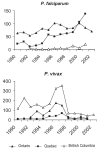Malaria epidemics and surveillance systems in Canada
- PMID: 15324537
- PMCID: PMC3323336
- DOI: 10.3201/eid1007.030826
Malaria epidemics and surveillance systems in Canada
Abstract
In the past decade, fluctuations in numbers of imported malaria cases have been seen in Canada. In 1997 to 1998, malaria case numbers more than doubled before returning to normal. This increase was not seen in any other industrialized country. The Canadian federal malaria surveillance system collects insufficient data to interpret these fluctuations. Using local (sentinel), provincial, federal, and international malaria surveillance data, we evaluate and interpret these fluctuations. Several epidemics are described. With an ever-increasing immigrant and refugee population of tropical origin, improved surveillance will be necessary to guide public health prevention policy and practice. The Canadian experience is likely to be generalizable to other industrialized countries where malaria is a reportable disease within a passive surveillance system.
Figures







Similar articles
-
[Current malaria situation in the Republic of Kazakhstan].Med Parazitol (Mosk). 2001 Jan-Mar;(1):24-33. Med Parazitol (Mosk). 2001. PMID: 11548308 Russian.
-
Malaria Surveillance - United States, 2018.MMWR Surveill Summ. 2022 Sep 2;71(8):1-35. doi: 10.15585/mmwr.ss7108a1. MMWR Surveill Summ. 2022. PMID: 36048717 Free PMC article.
-
The usefulness of school-based syndromic surveillance for detecting malaria epidemics: experiences from a pilot project in Ethiopia.BMC Public Health. 2016 Jan 9;16:20. doi: 10.1186/s12889-015-2680-7. BMC Public Health. 2016. PMID: 26749325 Free PMC article.
-
Malaria epidemic early warning and detection in African highlands.Trends Parasitol. 2004 Sep;20(9):400-5. doi: 10.1016/j.pt.2004.07.005. Trends Parasitol. 2004. PMID: 15324728 Free PMC article. Review.
-
El Niño and associated outbreaks of severe malaria in highland populations in Irian Jaya, Indonesia: a review and epidemiological perspective.Southeast Asian J Trop Med Public Health. 1999 Dec;30(4):608-19. Southeast Asian J Trop Med Public Health. 1999. PMID: 10928348 Review.
Cited by
-
Malaria in assam: a challenge.Indian J Community Med. 2009 Apr;34(2):94-6. doi: 10.4103/0970-0218.51225. Indian J Community Med. 2009. PMID: 19966952 Free PMC article.
-
Post-arrival screening for malaria in asymptomatic refugees using real-time PCR.Am J Trop Med Hyg. 2011 Jan;84(1):161-5. doi: 10.4269/ajtmh.2011.10-0494. Am J Trop Med Hyg. 2011. PMID: 21212221 Free PMC article.
-
Perioperative considerations of the patient with malaria.Can J Anaesth. 2015 Mar;62(3):304-18. doi: 10.1007/s12630-014-0286-7. Epub 2014 Dec 4. Can J Anaesth. 2015. PMID: 25471683 Free PMC article. Review.
-
Imported malaria in a cosmopolitan European city: a mirror image of the world epidemiological situation.Malar J. 2008 Apr 8;7:56. doi: 10.1186/1475-2875-7-56. Malar J. 2008. PMID: 18397524 Free PMC article.
-
Impact of routine real-time PCR testing of imported malaria over 4 years of implementation in a clinical laboratory.J Clin Microbiol. 2013 Jun;51(6):1850-4. doi: 10.1128/JCM.00195-13. Epub 2013 Apr 3. J Clin Microbiol. 2013. PMID: 23554200 Free PMC article.
References
-
- Statistics Canada. Causes of death 1990–1993 Catalogue #84-208; 1994–1995 Catalogue #84-208-XPB; 1996. Catalogue 84F0208; 1997–1999 Catalogue 84F0208XPB; 2000 Catalogue 84-208-XIE.
MeSH terms
LinkOut - more resources
Full Text Sources
Medical
Miscellaneous
